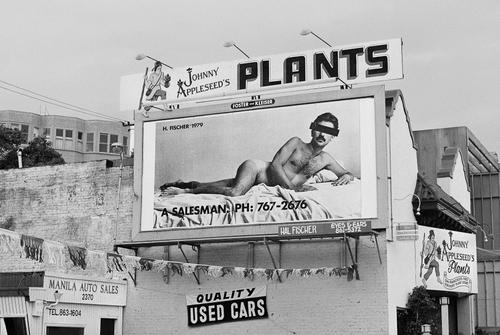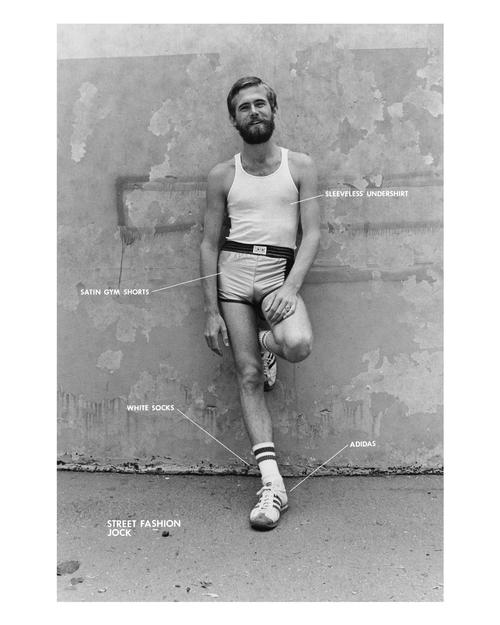Krannert Art Museum Acquires Complete Works of Gay Conceptual Photographer Hal Fischer
- CHAMPAIGN, Illinois
- /
- August 13, 2019

Photographer and University of Illinois alumnus Hal Fischer documented the gay community in 1970s San Francisco, creating a visual ethnography of that time.
Krannert Art Museum recently acquired the three portfolios of photographs Fischer produced It is the first museum with a complete set of his work. One portfolio will be featured in “Art Since 1948,” a new long-term installation of works from KAM’s collection of modern and contemporary art that will open Aug. 29. Fischer will return to campus Sept. 12 to receive a distinguished alumni award from the School of Art and Design.
“There was a historical moment between Stonewall in 1969 and the beginning of gay liberation, and the moment at the beginning of the ’80s when AIDS appears and decimates the gay community,” said Tim Dean, an Illinois English professor who researches in gender and sexuality studies. “Fischer is working in the decade between those two moments, producing a visual record of the experimentation that gay men in the urban enclave of San Francisco were engaging in.”

Fischer’s iconic series of conceptual photographs is being rediscovered, said Amy Powell, the curator of modern and contemporary art at KAM. Renewed interest in his work began after it was included in “Pacific Standard Time: Art in L.A. 1945-1980,” a series of exhibitions in 2011-12 on the art of Southern California and its influence. Fischer began reprinting his earlier work in 2015.
Terri Weissman, an art history professor who teaches courses on photography, said Fischer’s photographs illustrate a shift beginning in the mid-1960s when many photographers began making work that was more overtly conceptual or theoretically oriented.
“It’s emblematic of a particular moment in photography’s history when photography and language come together, and when many photographers think of themselves more as artists who use photography rather than ‘art photographers,’” Weissman said.
“Artists were thinking about the relationship between image and symbol, language and meaning. Hal Fischer’s work is really at the center of that,” Powell said. “It’s very much playing with categorizations, and also drawing on photography’s ability to document and categorize.”
Fischer’s work shows the paradox of photography in that it purports to depict its subjects in an objective or neutral manner, when in fact it is invested with political, cultural and social meaning, Weissman said. His portfolio “Gay Semiotics” depicts the codes gay men were using, such as wearing an earring, handkerchief or keychain to signify a particular meaning. The text on the photographs notes the intended meaning, giving the portfolio the feel of an instruction manual.
“Fischer has said it was a moment when it could be dangerous for a gay guy in San Francisco to approach a straight guy. You had to know how to read these codes,” Weissman said. “It’s a deeply political message, but he presents it with this humor.”
The text points out that a particular article of clothing – seemingly sending a message to a person in the know – could also be just a piece of clothing. A photo of men wearing keychains attached to their jeans includes text that dryly reads: “Keys are also worn by janitors, laborers and other workers with no sexual signification intended.”
Dean described the photographs as provocative, witty and funny.
“One of the things I really appreciated was the guy had a sense of humor about it all. A lot of it is tongue-in-cheek and irreverent,” he said. “It was a moment of gay liberation, a moment of sexual experimentation, a moment that gay people were still extraordinarily oppressed, but he’s having fun with it all as he’s doing it.”
Dean is interested in what the visual codes in the photos say about representation and identity, and how people connected before online dating sites existed. He said he’d like students to think: “How do I signal, in my online profiles, what kind person I want to hang out with, what sort of person I want to be friends with. We are hyperconscious about curating an image online to impress people. Thinking historically about those photos can lead students to think about how they conduct their own lives.”
Fischer’s portfolio “18th St. Near Castro” – featured at Art Basel in Switzerland in June – is experimental work in which he photographed a bench every hour for 24 hours at 18th and Castro streets in San Francisco and recorded the neighborhood community.
The portfolio “Boy-Friends” comprises 10 photographs of men with whom Fischer had a relationship, with accompanying text describing them as archetypes (e.g., The Gym Attendant, A Hippie, The Punk Poet), and relating how they and Fischer met. The photos include censorship bars over the men’s eyes to depersonalize them and play on the visual codes of advertising, Powell said.
“KAM has a strong photography collection, and this purchase really expands it. Fischer’s work aligns with other artists who are examining the relationship between text and image, paying attention to gender, sexuality and desire,” Powell said.
KAM has photographs in its collection from other California conceptual photographers, as well as other gay photographers who are exploring desire in their images, she said.
The museum was able to acquire Hal Fischer’s body of work with the help of Robert and Sonia Carringer, who not only introduced the work to KAM but also funded the acquisition, Powell said. Fischer was a student of Robert Carringer at the U. of I.
Powell plans to include all of Fischer’s work in a future exhibition at the museum.
# # #
Contact:
Julia Nucci KellyKrannert Art Museum, University of Illinois
217-244-0320
kam-info@illinois.edu
500 E. Peabody Drive, MC-592
Champaign, Illinois
kam@illinois.edu
217-333-1861
http://kam.illinois.edu
About Krannert Art Museum
About Krannert Art Museum Krannert Art Museum and Kinkead Pavilion (http://kam.illinois.edu) promotes a vibrant exchange of ideas in the visual arts. The museum’s rich permanent collection contains over 10,000 works of art dating from the fourth millennium BCE to the present, making Krannert Art Museum the second-largest general fine art museum in Illinois. A unit of the College of Fine + Applied Arts (http://faa.illinois.edu) at the University of Illinois at Urbana-Champaign (http://illinois.edu), the museum is located at the corner of Sixth St. and Peabody Dr. in Champaign, Ill. Complete information on events, exhibitions, location and hours of operation is available via the museum website.





5100x100_c.jpg)









